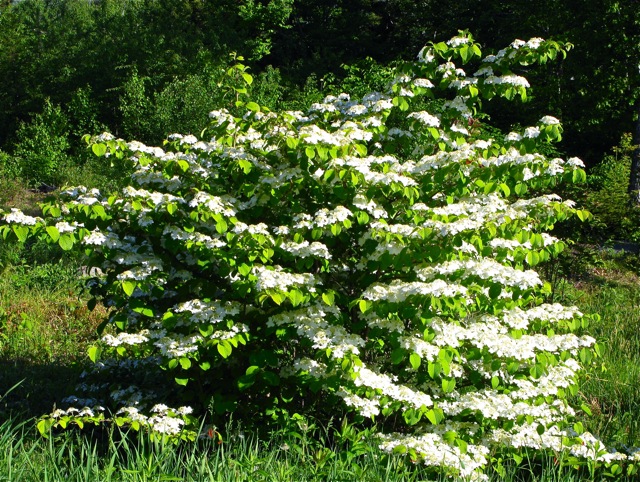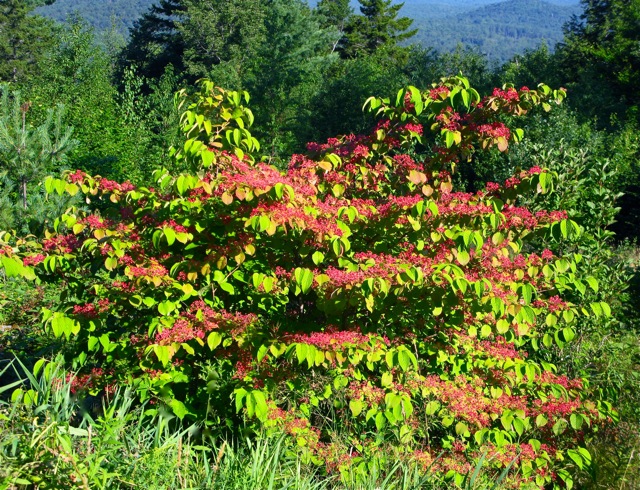Delightful Doublefile Viburnum ‘Shasta’: Ripe with Fruit & Filled with Songbirds
 Viburnum plicatum var. tomentosum ‘Shasta’ â“’ Michaela at TGE (fruits in July)
Viburnum plicatum var. tomentosum ‘Shasta’ â“’ Michaela at TGE (fruits in July)
Graceful, elegant and generous are but a few of the words that spring to mind when describing Doublefile Viburnum, (V. plicatum var. tomentosum); one of the most delightful species in my absolute favorite genus of woody plants. Although this shrub wears no perfume in springtime, she more than makes up for her lack of fragrance with four-season beauty and an easy-to-please manner (this species shows greater resistance to the viburnum beetle than other members of the genus, but prefers evenly moist, woodsy soil – it blooms equally well in full sun to partial shade). Doublefile Viburnum’s tiered, horizontally branching form reminds me a bit of another Asian native, the lovely Korean dogwood (Cornus kousa). The shape of this woody plant is truly stunning —especially in winter— and it can be used to great effect when positioned to soften the edge of a building. Triangulated in groups of three or more, Doublefile Viburnum creates a sophisticated, yet natural-looking screen; the dense, twiggy framework concealing eyesores almost as well as a conifer hedge.
My favorite large-sized cultivars, V. plicatum var. tomentosum ‘Shasta’ and ‘Mariesii’ (10′ x 12′), and the compact ‘Newport’ (3-4′ x 4-5′) —all hardy in USDA zones 4/5-9— fill the garden with a constellation of starry, white blossoms from mid May to late June. A magnet for bees and butterflies in spring and early summer, during the summer months of July and August the large Doublefile Viburnums are loaded with bright red berries, which attract cedar waxwings, sparrows, mockingbirds, thrushes and a wide variety of other songbirds to the garden (compact cultivar ‘Newport’ can be a bit stingy with fruit production). Although the fruits eventually mature to black in late August, the shrubs on my property are usually picked clean long before the berries deepen to black. Later in the season, as days shorten and temperatures cool, the foliage of this species begins to subtly shift. First lightening to chartreuse and cherry, then deepening to burgundy red, and eventually burnishing to a fine shade of oxblood, Doublefile Viburnum puts on a fine fashion show before shedding her cloak for winter….
 Doublefile Viburnum (Viburnum plicatum var. tomentosum) ‘Shasta’ in June â“’ Michaela at TGE
Doublefile Viburnum (Viburnum plicatum var. tomentosum) ‘Shasta’ in June â“’ Michaela at TGE
 Viburnum plicatum var. tomentosum ‘Shasta’ at the edge of the meadow in July  Photo â“’ Michaela at TGE
Viburnum plicatum var. tomentosum ‘Shasta’ at the edge of the meadow in July  Photo â“’ Michaela at TGE
 Although Doublefile Viburnum’s red berries eventually ripen to black, the shrub is usually picked clean by birds long before the ruby fruit turns ebony. Â Photograph â“’ Michaela at TGE
Although Doublefile Viburnum’s red berries eventually ripen to black, the shrub is usually picked clean by birds long before the ruby fruit turns ebony. Â Photograph â“’ Michaela at TGE
 Viburnum plicatum var. tomentosum ‘Shasta’ in late September. Foliage color slowly morphs from chartreuse and cherry red to burgundy, eventually deepening to oxblood over the course of autumn. Photo â“’ Michaela at TGE
Viburnum plicatum var. tomentosum ‘Shasta’ in late September. Foliage color slowly morphs from chartreuse and cherry red to burgundy, eventually deepening to oxblood over the course of autumn. Photo â“’ Michaela at TGE
***
Article and photographs © 2010 Michaela at The Gardener’s Eden
All content on this site, (with noted exceptions), is the property of The Gardener’s Eden and may not be used or reproduced without prior written consent. Inspired by something you see here? Great! Please give credit where credit is due. It’s a small world and link-love makes for fond friendships. Stealing makes for bad dreams…
Do you enjoy visiting The Gardener’s Eden? You can help support this site by shopping through our affiliate links. A small percentage of any sale originating from The Gardener’s Eden site will go toward web hosting and maintenance costs. Thank you for your support!
***
4 Replies to “Delightful Doublefile Viburnum ‘Shasta’: Ripe with Fruit & Filled with Songbirds”
Comments are closed.

Your doublefile ‘Shasta’ is stunning. I love your blog for the plant profiles to see what my little plants will look like some day. My ‘Shasta’ viburnum is just coming into its own this year (3rd year in my garden, but it had a traumatic move the second year). It has started to show its lovely shape and it flowered (and fruited) beautifully this year. Fall color is more rusty brown than burgundy, but it works with the background plants near it. Now I can’t wait for mine to look like the mature one in your photos. Nice!
Thank you Laurie. I wish I could take credit for my Shasta’s beauty, but she really does all the work herself. I simply stuck her in the ground and let her go (at the naturalized edge of my garden). She really is my favorite of the doublefiles, although the genus as a whole rocks my world. I need to make more time for plant profiles. I enjoy my unofficial role in plant PR ;)
I hope you are having a lovely summer – we certainly are getting an old-fashioned one here in New England!
xo M